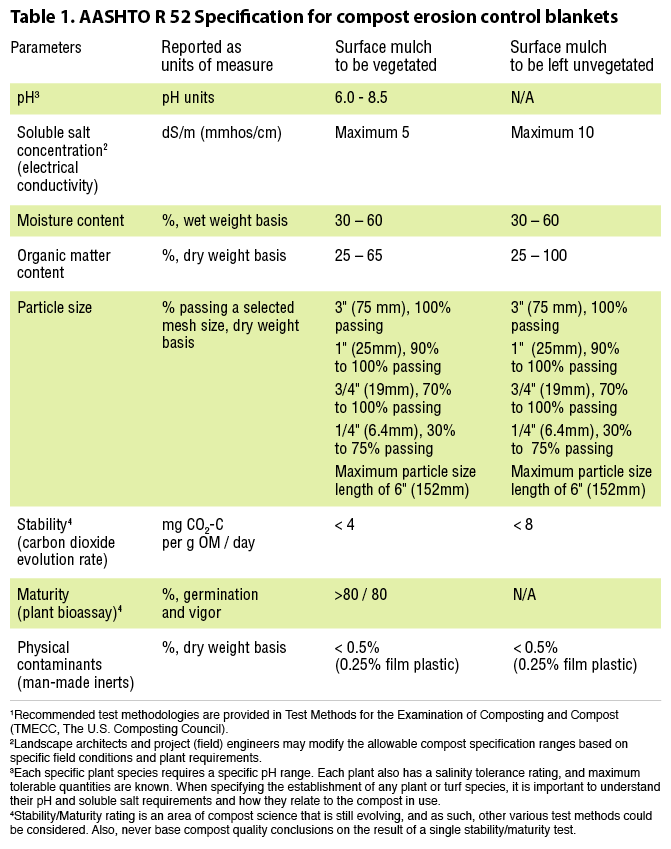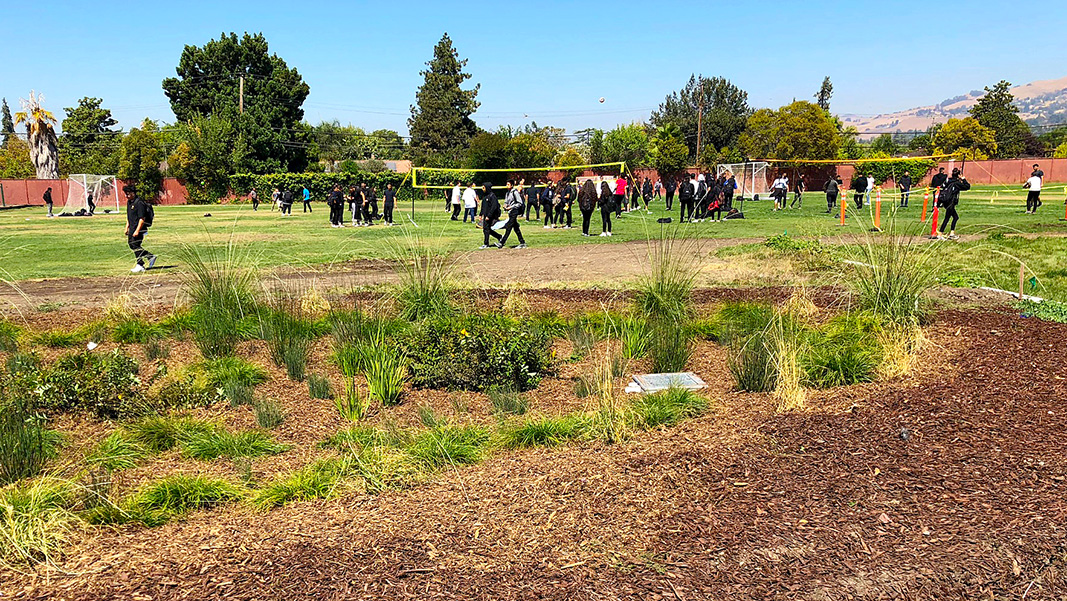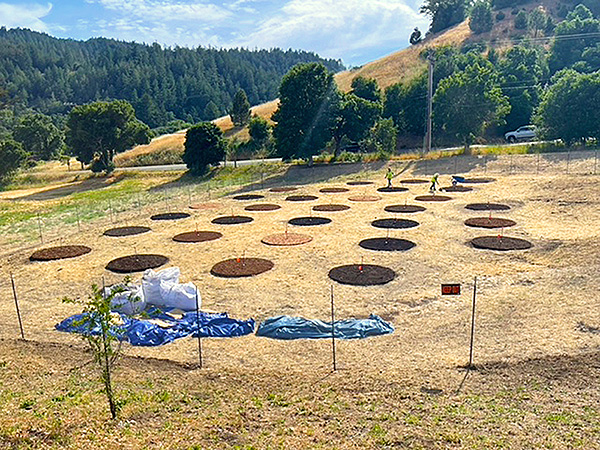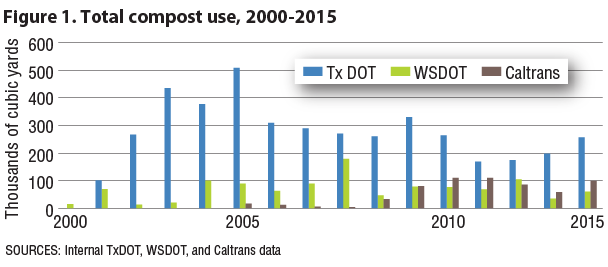Top: Applied composted mulch at Voices Academy, Morgan Hill, California. Photo courtesy Beto Ochoa, GreenWaste
Ron Alexander
Mulching is a well-documented horticultural and agricultural practice. It provides a variety of benefits including improved moisture conservation, reduced soil erosion, weed suppression, and lowering soil temperatures. When using carbon-based mulches versus materials like stones and chipped tires, it also provides organic matter and plant nutrients to the soil, as well as carbon to feed microbes and other creatures living in the soil. In landscaping and home gardening, mulches are also used for aesthetics purposes. However, with the climate changing, creating more droughts and intense rainstorms, mulching will be seen as an even more important tool in soil and plant management, food production, etc.
Over the past 45 years, commercial composts have become staples of the landscaping and gardening industries, supplying them with high quality and inexpensive soil amendments. Their use has expanded in both agricultural production and erosion control and storm water management. However, certain medium or coarsely screened composts, as well as ‘clean’ screened compost ‘overs’ generated through the composting of yard trimmings and biosolids, have also been used as decorative and horticultural mulches in both landscaping and agricultural production.
While the overall appearance of a composted mulch is probably the greatest driver regarding its acceptability in landscaping, its ability to feed the soil and the plants grown within it should not be overlooked. Popular composted landscape mulches possess a consistent appearance, are dark in color, and have a lower C:N ratio. Of course, there are exceptions, as some customers will use products that are lighter in color (less composted or aged). Most composted mulches contain a mixture of coarse, medium and fine particles — ranging in size from 0.5 to 2 inches — which is no doubt key to their efficaciousness in a variety of applications. While the content of thoroughly composted particles can increase the mulches bulk density when compared to dyed wood or fresh bark mulches, it also helps them hold more water, reduce migration (especially when there is a stringy component), provides stabilized organic matter and feeds the plants. For agricultural applications, the horticultural benefits that a composted mulch can provide are more important than its appearance, as are its overall cost.
Uniqueness Of Composted Mulches
What many people don’t know is that composted mulches are quite unique and provide even more benefits than more conventional mulches.
- Improved Nitrogen Availability and Plant Growth: Research completed at the Ohio State University (OSU) illustrated that mulching with composted yard waste, with a low C:N ratio of 17:1, dramatically increased total soil nitrogen as well as nitrogen mineralization rate over plots with bare soil or ground pallet wood mulch (Herms, et al., 1997). This increased plant available nitrogen, as well as foliar nitrogen concentration and growth, led to significantly increased plant growth in River Birch. Related research at OSU showed that Rhododendrons grew significantly greater amounts of flowers when mulched with composted yard trimmings, as compared to bare soil and ground pallet wood mulch.
- Higher Water Holding Capacity: Research completed by the University of California Cooperative Extension in San Diego (Shaw et al., 2005) illustrated that partially composted yard trimmings and composted mulches held more water in their 12-product trial than other carbon-based, mineral and synthetic mulches. This is likely caused by the fact that finer particles can more readily absorb water than larger particles and the combination of pore space sizes in composted mulches allow for improved water capture.
- Lower Combustibility: Research completed by Stephen Quarles, while at the University of California Cooperative Extension, and others suggests that composted mulches are less combustible than other wood and bark-based mulches. This is likely due to their water holding capacity, orientation to the soil (allowing less oxygen in the mulch layer) and content of mineral soil particles. This research is very important for wildfire prone states like California.
- Erosion and Sediment Control: Medium and coarse grade composts have been used as erosion and sediment control tools for over 25 years in certain regions of the U.S. The American Association of State Highway Transportation Officials (AASHTO) first published specifications for compost blankets in 2003, but they were used by the Maine Department of Transportation (DOT) and other early adopters long before that. AASHTO published an updated compost blanket specification in January 2023 (Table 1). A compost blanket’s effectiveness relies on an appropriate woody fraction content, which reduces its slippage factor on slopes, as well as its ability to hold water and quickly establish vegetation.

- Reduced Floatability: As low impact development expands, so has the usage of bioretention features to manage storm water. As part of these living systems, which can remove nutrients, heavy metals and petroleum hydrocarbons from water, a carbon-based mulch is usually specified for use. The mulch layer improves plant growth, reduces irrigation needs, and protects the ‘soil’ media from erosion. In this environment and during heavier rain events, wood and bark-based mulches are known to float and then migrate. During research completed in New Zealand and field trials completed in California (by R. Alexander in 2019), it was found that stringier mulches possessing a higher bulk density float and migrate less in biotreatment conditions. A mulch specification was developed around this research and is currently being used in the Bay Area of California.

Field trials testing floatability of composted mulch were completed at GreenWaste’s Gilroy, California facility.
Composted mulch markets are expanding all over the U.S. As end users become more familiar with them and experience their benefits in the field, compost manufacturers will be pushed to expand their production of these versatile and efficacious products. However, to succeed in this marketplace, composters will have to better manage their incoming feedstocks and/or learn to more efficiently manage physical contamination, assure PFRP (process to further reduce pathogens) composting so weeds and pathogens are destroyed, and work on improving the product’s appearance (at least in the landscape and gardener markets). If these steps are achieved, they can expand their product line and create another profitable product for the market. Remember, most landscapers use more mulch than they do soil amendments (compost).
Ron Alexander is president of R. Alexander Associates, Inc. (Apex, North Carolina, 919-367-8350), a company specializing in product and market development for organic recycled products. He is author of ”The Practical Guide to Compost Marketing and Sales” (2nd Edition published by BioCycle) and has over 40 years of experience in compost and recycled organics product marketing. Mr. Alexander is a member of the US Composting Council’s Seal of Testing Assurance (Program) Advisory Committee and is an Industry Liaison to AAPFCO (Association of American Plant Food Control Officials).
References
Herms, D.A., Lloyd J.E., and Stinner, B.R. Effects of Organic Mulches and Fertilization on Soil Microbial Activity, Nutrient Availability, and Growth of River Birch. 1997.
Shaw A., D.R. Pittenger, and M. McMaster. Water Retention and Evaporative Properties of Landscape Mulches. Proc. 26th Annl. Irrigation Show, Irrigation Assoc., Falls Church, VA. 2005.




 The goal of the webinar was to inform California compost manufacturers about the ongoing demand for medium and coarse compost by Caltrans, and the shortfalls in supply that they are facing. The 60+ attendees were shown how Caltrans is using medium and coarse compost, as well as other potential markets and applications for these products.
The goal of the webinar was to inform California compost manufacturers about the ongoing demand for medium and coarse compost by Caltrans, and the shortfalls in supply that they are facing. The 60+ attendees were shown how Caltrans is using medium and coarse compost, as well as other potential markets and applications for these products.











